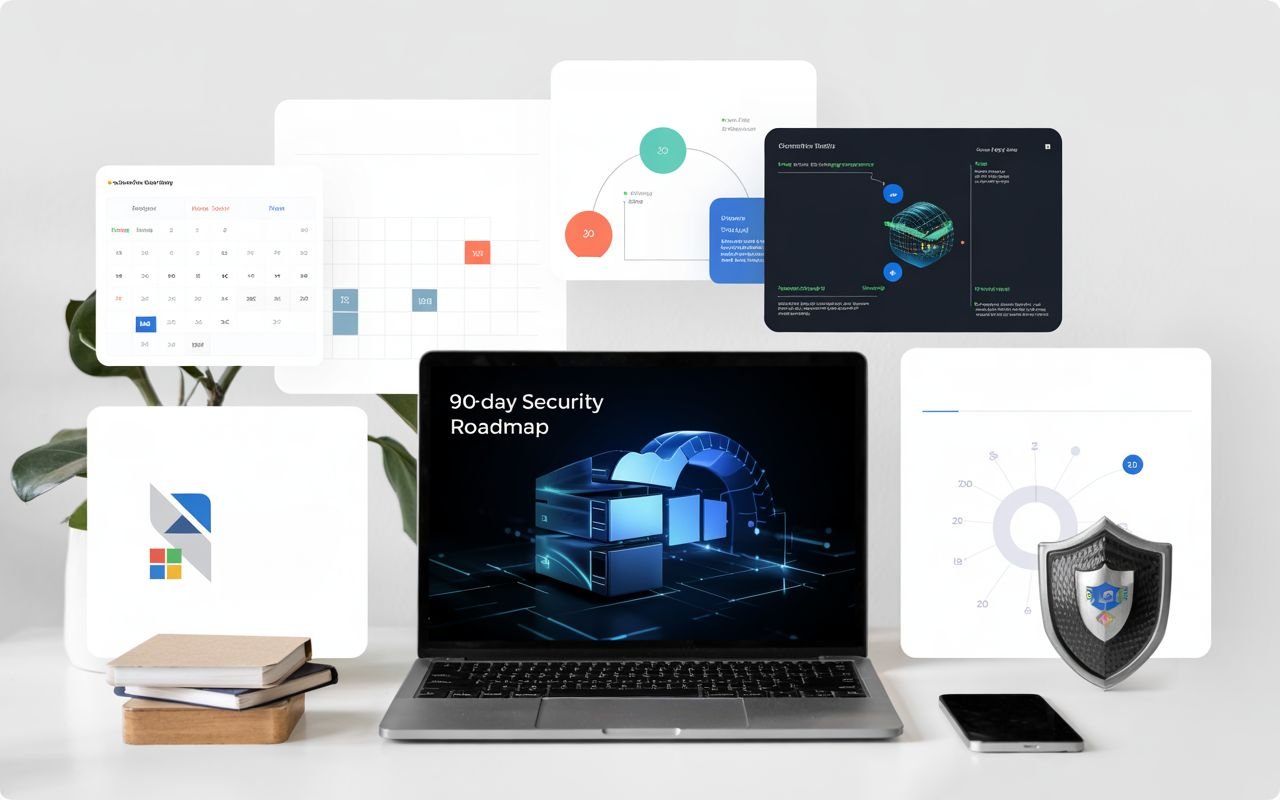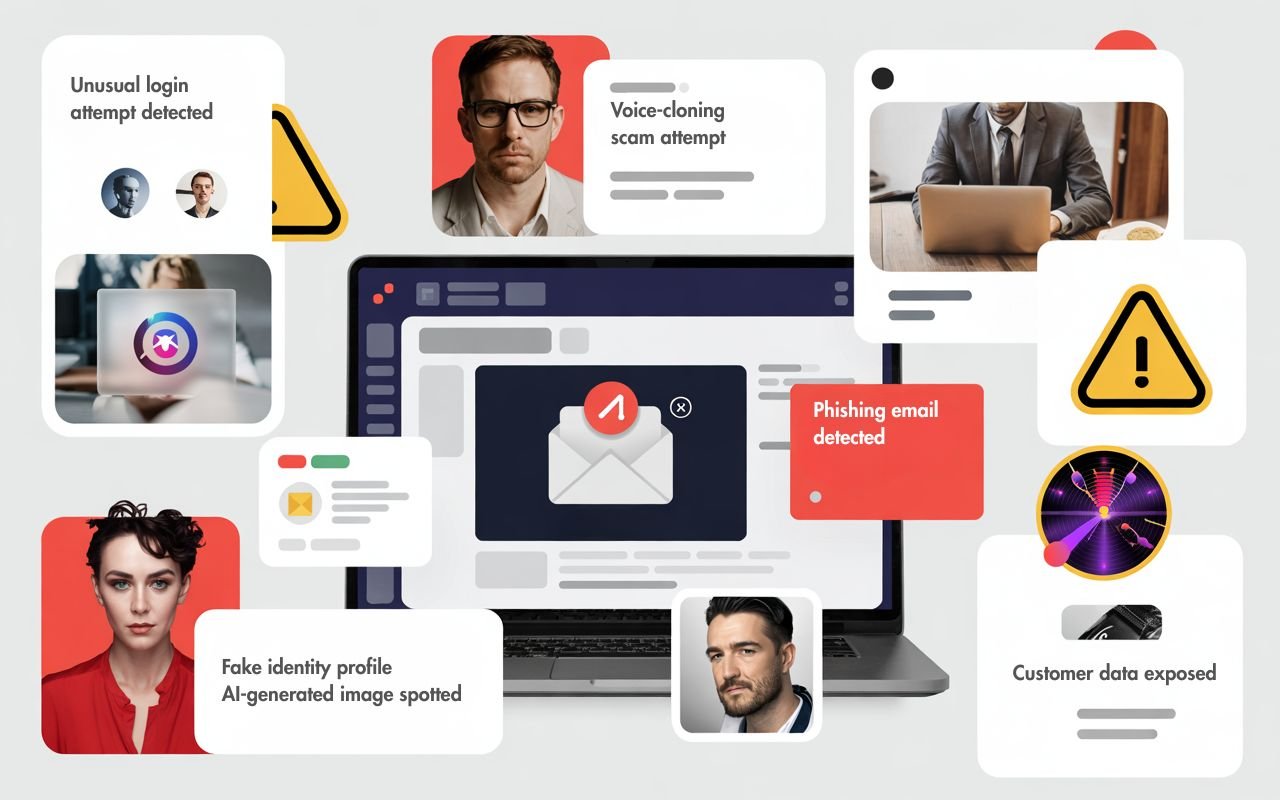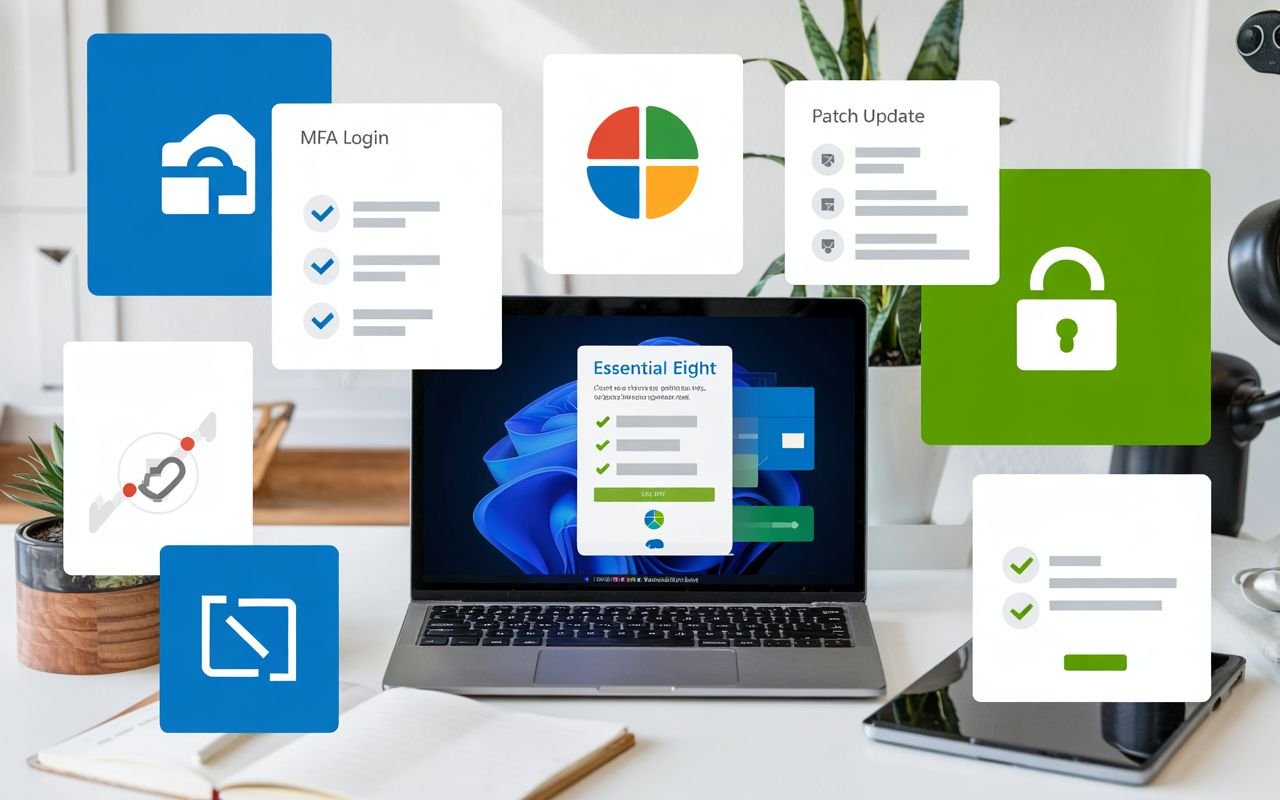Top Cybersecurity Risks for SMEs in Australia: Best Practices 2025
A comprehensive 2025 guide for Australian small and medium enterprises: risks, regulations, and practical protection
Executive key takeaways
- • Attack tempo is relentless: The ACSC reports near-constant cyber activity against Australian organisations assume compromise and build layered defences (ACSC threat report).
- • AI supercharges crime: Personalised phishing, voice cloning, and automated reconnaissance raise success rates people-centric controls matter as much as tech (analysis).
- • Regulation is tightening: The Cyber Security Act 2024 and privacy reforms expand reporting and penalties treat cyber risk as a legal and financial exposure, not just IT’s problem (CISC reforms).
- • What works now: Implement the Essential Eight to Maturity Level 1, enforce MFA beyond email, deploy 3-2-1 backups with an offline copy, and automate patching.
- • BEC is the budget killer: Payment redirection via compromised email remains the costliest SME threat add call-back verification to known numbers and dual approval for bank detail changes.
- • Backups only count if tested: Monthly restore tests prevent “Schrödinger’s backup” during ransomware events measure RTO/RPO against real operations (ACSC SMB guide).
- • People are control surface #1: Run quarterly simulations (phishing, BEC, vishing) and short, role-based refreshers; align policy, process, and tooling.
- • Insurers expect hygiene: Cyber insurance increasingly requires MFA, backups, patching, and training lift controls to maintain coverage and lower premiums (market view: Marsh).
- • Board-ready roadmap: 90-day sprint for hygiene; 12-month plan for segmentation, privileged access, and incident response maturity; 3–5 year roadmap tied to refresh cycles and regulatory milestones.
Turn strategy into skills: book applied sessions via Nexacu professional development and map controls to AU standards with Microsoft’s Essential Eight mapping.
Jump to: Introduction • Current Threat Landscape • Primary Risks • Regulation & Compliance • Best Practices • Advanced Measures • Industry Considerations • Government Support • Financials & ROI • Conclusion
Introduction
The cybersecurity landscape for Australian small and medium enterprises has reached a critical juncture in 2025, with cybercriminals launching sophisticated attacks at an unprecedented rate. According to the Australian Cyber Security Centre’s latest Annual Cyber Threat Report 2023–24 and Ministerial briefings (Minister for Defence), attacks are reported roughly every six minutes nationwide. The average financial impact on small businesses is frequently cited near $50,000 per incident in media and industry summaries (Inside Small Business; Business NSW).
The regulatory environment is also tightening. The Cyber Security Act 2024 and Privacy Act reforms (analysed by Bird & Bird and CyberCX) introduce stronger reporting and penalties through 2025–26. Meanwhile, AI-enabled social engineering and supply-chain compromises are accelerating (SecurityBrief AU; Cyble).
The Current Threat Landscape for Australian SMEs
Rising Attack Frequency and Sophistication
The ACSC recorded over 87,000 cybercrime reports in 2023–24 about one every six minutes underscoring relentless activity against Australian businesses (ACSC Annual Cyber Threat Report). Attacks increasingly target operational technology and IoT; Australia ranks among the most targeted for attacks on industrial systems (Australian Cybersecurity Magazine). Manufacturing and mining are prominent targets.
AI-Powered Threat Evolution
AI now fuels phishing, voice cloning, lure generation, and scaled reconnaissance. Australian media and research call out growing AI contributions to cyber incidents (SecurityBrief AU). Supply-chain compromises and BEC (business email compromise) are supported by AI-assisted pattern analysis (Cyble).

Primary Cybersecurity Risks Facing Australian SMEs
Business Email Compromise and Invoice Fraud
BEC is frequently the most financially damaging threat for SMEs. Criminals infiltrate email, study supplier cycles, and inject fraudulent payment instructions. See overviews and case patterns via Boost IT, with real SME losses documented by Synergy IT. Dual verification (call-back to a known number) and payment hold thresholds are essential.
Ransomware and Data Encryption Attacks
Ransomware now commonly uses “double extortion” (encrypt + leak threat). Australian reporting emphasises SME targeting (iTnews). The ACSC’s updated guidance details prevention and recovery, including offline backups and incident response (Small Business Cyber Security Guide (Jan 2025)).
Social Media Account Takeovers
Compromised social accounts lead to ad spend abuse, customer scams, and brand harm widely reported across small-business media (Inside Small Business). Lock down admins with MFA, monitor billing, and establish quick recovery channels with platforms.
Online Shopping and Supply Chain Scams
From fake equipment sellers to intercepted supplier emails, scams exploit long purchase cycles. Read threat research (Cyble) and local case studies (Synergy IT). Use purchase orders, verified payee controls, and escrow where possible.
Data Breaches and Inadequate Backup Practices
OAIC breach reports remain elevated, while many SMEs still lack encryption at rest and maintain backups that are reachable by ransomware. Start with ACSC’s baseline controls (ACSC Small Business Guide) and align to the Essential Eight.

Regulatory and Compliance Landscape in 2025
Cyber Security Act 2024 Implementation
The Act introduces ransomware payment reporting and minimum security for smart devices rolling in. Track official updates via Home Affairs and the Cyber and Infrastructure Security Centre. Plain-English summaries appear in industry analysis (CyberCX).
Privacy Act Reforms and Data Protection
Tougher penalties, expanded reporting, and a statutory tort for serious privacy invasion increase legal exposure. For context, see Bird & Bird and CyberCX.
Industry-Specific Compliance Requirements
APRA CPS 230 (operational risk), NDIS safeguards, PCI DSS for retailers, and critical infrastructure obligations all matter in 2025. NSW policy guidance for the Essential Eight is here: Digital NSW – Essential Eight policy.

Essential Cybersecurity Best Practices for Australian SMEs
Multi-Factor Authentication Implementation
- MFA is the single highest-ROI control. Prioritise email, admin accounts, remote access, banking, socials. Prefer authenticator apps or hardware keys over SMS. Align with the ACSC’s Essential Eight.
- Cyber insurers increasingly require MFA; see market insights from Marsh.
- Upskill teams around Microsoft 365 MFA flows via Nexacu’s Microsoft Office training courses.
Comprehensive Backup and Recovery Strategies
- Apply 3-2-1: three copies, two media, one offline. Test restores monthly. See ACSC’s Small Business Cyber Security Guide.
- Cloud backup can help with sovereignty and automation; validate recovery time (RTO/RPO) against operations.
Employee Security Awareness and Training
- Quarterly refreshers; simulate phishing, BEC verification drills, and voice-phishing (vishing).
- Integrate cyber awareness into broader upskilling via Nexacu professional development.
Network Security and Access Control Implementation
- Enforce least privilege; review admin rights quarterly; segment networks (servers vs endpoints vs OT/IoT).
- Harden routers and Wi-Fi (unique admin creds, WPA3). Reference Australian checklists such as BlueShield AU.
Software Updates and Patch Management
- Automate OS and app updates; retire end-of-life systems. Map to the Essential Eight and Microsoft’s AU E8 mapping (Microsoft Learn).
- Plan maintenance windows; reduce disruption with staff comms. See Nexacu Microsoft training.
Advanced Security Measures and Professional Support
Cyber Insurance and Risk Transfer
Policies can cover incident response, forensics, legal costs, BI loss, and regulatory penalties. See market views and case studies from Marsh and Chubb. Many underwriters now require MFA, backups, and training.
Professional Cybersecurity Services and Support
If internal capacity is limited, consider MSSPs, SOC monitoring, MDR, and periodic audits. Compare options via Australian providers and training pathways. Align with the Information Security Manual (ISM).
Incident Response Planning and Business Continuity
Plan & test: Define detection, containment, eradication, and recovery steps; assign roles and comms; practice quarterly tabletop exercises using ACSC guidance.

Industry-Specific Considerations and Compliance
Healthcare and Professional Services
Sensitive data, NDIS standards, and professional obligations require strong classification, encryption, and IR readiness. Document procedures and evidence handling to support compliance and client trust.
Retail and E-commerce Operations
Comply with PCI DSS; harden CMS and payment gateways; enable MFA for admins and customers; prepare clear breach comms templates (reset instructions, fraud advice) to protect reputation and reduce churn.
Manufacturing and Supply Chain Operations
Secure OT/ICS; segment production networks; include supplier security clauses (minimum controls, incident notification SLAs). Australia’s critical-infrastructure threat profile is evolving monitor ACSC and CISC updates.
Government Resources and Support Programs
- ACSC Small Business Cyber Security Guide (Jan 2025): Practical steps & checklists download.
- ACSC Reports & Statistics + Hotline (1300 CYBER1): Trends, alerts, and help ACSC portal.
- IDCARE SME support: Free assessments and personalised guidance case examples.
Financial Considerations and Return on Investment
Average direct costs per SME incident are commonly reported around ~$50k, excluding downtime and reputation impact (Inside Small Business). Prevention (MFA, backups, patching, training) is consistently cheaper than cure; Essential Eight Maturity Level 1 provides a strong baseline at modest cost. Insurers and markets reinforce the business case (Marsh; SecurityBrief AU).
- Funding options: Consider instant asset write-off for security tech, group purchasing via associations, and insurance incentives.
- Roadmap: Build a 3–5 year security plan aligned to growth, refresh cycles, and regulatory milestones; integrate training paths via Nexacu certification programs and professional development.
Conclusion and Strategic Recommendations
The 2025 threat environment demands immediate, practical action. Begin with the Essential Eight, roll out MFA everywhere, enforce 3-2-1 backups with offline copies, automate patching, and train continuously. Create and rehearse an incident response plan and consider cyber insurance for residual risk. Use Australian guidance (ACSC, CISC) and hands-on upskilling via Nexacu to turn controls into repeatable workflows that reduce risk and support growth.
90-day plan: (1) Map current posture to the Essential Eight. (2) Deploy MFA, backup testing, and patch automation. (3) Run a tabletop IR exercise. (4) Book targeted training with Nexacu professional development.
Further Reading & Resources
- ACSC Annual Cyber Threat Report 2023–24
- ACSC Small Business Cyber Security Guide (Jan 2025)
- Cyber Security Act 2024 (Home Affairs)
- Cyber & Infrastructure Security Centre – Legislative reforms
- NSW Government – Essential Eight policy
- Microsoft – Essential Eight mapping for AU
- Nexacu – Microsoft Office training
- Nexacu – Professional development


























